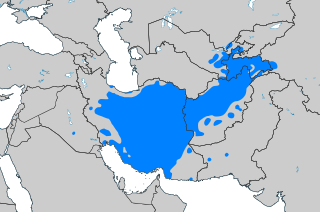
Back Nuevo persa Spanish زبان فارسی نو Persian Bahasa Persia Baru ID نوې پارسي ( دری ) Pashto/Pushto Novoperzské jazyky Slovak Форсии нав Tajik ภาษาเปอร์เซียใหม่ Thai Dəri (Farsi) TLY
| New Persian | |
|---|---|
| فارسی نو, پارسی نو | |
 Fārsi written in Persian calligraphy (Nastaʿlīq) | |
| Native to |
|
Native speakers | 70 million[7] (110 million total speakers)[6] |
Early forms | |
| Persian alphabet (Iran and Afghanistan) Tajik alphabet (Tajikistan) Hebrew alphabet Persian Braille | |
| Official status | |
Official language in |
|
| Regulated by |
|
| Language codes | |
| ISO 639-1 | fa |
| ISO 639-2 | per (B) fas (T) |
| ISO 639-3 | fas |
| Glottolog | fars1254 |
| Linguasphere | 58-AAC (Wider Persian) > 58-AAC-c (Central Persian) |
 Areas with significant numbers of people whose first language is Persian (including dialects) | |
 Persian Linguasphere. Legend Official language
More than 1,000,000 speakers
Between 500,000 – 1,000,000 speakers
Between 100,000 – 500,000 speakers
Between 25,000 – 100,000 speakers
Fewer than 25,000 speakers / none | |
New Persian (Persian: فارسی نو, romanized: Fārsī-ye No), also known as Modern Persian (فارسی نوین) is the current stage of the Persian language spoken since the 8th to 9th centuries until now in Greater Iran and surroundings. It is conventionally divided into three stages: Early New Persian (8th/9th centuries), Classical Persian (10th–18th centuries), and Contemporary Persian (19th century to present).
Dari is a name given to the New Persian language since the 10th century, widely used in Arabic (see Istakhri, al-Maqdisi and ibn Hawqal) and Persian texts.[10] Since 1964, Dari has been the official name in Afghanistan for the Persian spoken there.
- ^ a b c Samadi, Habibeh; Nick Perkins (2012). Martin Ball; David Crystal; Paul Fletcher (eds.). Assessing Grammar: The Languages of Lars. Multilingual Matters. p. 169. ISBN 978-1-84769-637-3.
- ^ "IRAQ". Encyclopædia Iranica. Retrieved 7 November 2014.
- ^ "Tajiks in Turkmenistan". People Groups.
- ^ Pilkington, Hilary; Yemelianova, Galina (2004). Islam in Post-Soviet Russia. Taylor & Francis. p. 27. ISBN 978-0-203-21769-6.
Among other indigenous peoples of Iranian origin were the Tats, the Talishes and the Kurds.
- ^ Mastyugina, Tatiana; Perepelkin, Lev (1996). An Ethnic History of Russia: Pre-revolutionary Times to the Present. Greenwood Publishing Group. p. 80. ISBN 978-0-313-29315-3.
The Iranian Peoples (Ossetians, Tajiks, Tats, Mountain Judaists)
- ^ a b Windfuhr, Gernot: The Iranian Languages, Routledge 2009, p. 418.
- ^ "Persian | Department of Asian Studies". Retrieved 2 January 2019.
There are numerous reasons to study Persian: for one thing, Persian is an important language of the Middle East and Central Asia, spoken by approximately 70 million native speakers and roughly 110 million people worldwide.
- ^ Constitution of the Islamic Republic of Iran: Chapter II, Article 15: "The official language and script of Iran, the lingua franca of its people, is Persian. Official documents, correspondence, and texts, as well as text-books, must be in this language and script. However, the use of regional and tribal languages in the press and mass media, as well as for teaching of their literature in schools, is allowed in addition to Persian."
- ^ Constitution of the Republic of Dagestan: Chapter I, Article 11: "The state languages of the Republic of Dagestan are Russian and the languages of the peoples of Dagestan."
- ^ "DARĪ – Encyclopaedia Iranica".